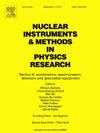紧凑型托卡马克中子探测器的设计
IF 1.5
3区 物理与天体物理
Q3 INSTRUMENTS & INSTRUMENTATION
Nuclear Instruments & Methods in Physics Research Section A-accelerators Spectrometers Detectors and Associated Equipment
Pub Date : 2025-03-25
DOI:10.1016/j.nima.2025.170456
引用次数: 0
摘要
目前在托卡马克装置中使用的大多数中子光谱仪都是基于液体闪烁体和光电倍增管(pmt)耦合的,由于其体积大且易受电磁干扰,因此存在挑战。近年来,硅光电倍增管以其体积小、量子效率高、抗电磁干扰等优点逐渐取代传统的光电倍增管。本研究提出了一种用于托卡马克中子诊断的新型中子探测器,其中中子探测器由BC-501 a液体闪烁体与SiPM阵列耦合组成。该中子探测器可用于中子通量监测,并与光谱反褶积相结合,也可用于光谱测量。用几种同位素伽玛源对探测器进行了标定,并在Am-Be中子源和HL-3装置上验证了探测器的鉴别性能。Am-Be中子源实验结果表明,在200-800 keee能量范围内,n/γ优值(FOM)为1.56。同样,在HL-3装置上进行的现场实验表明,在相同的分辨能范围内,FOM为1.61。此外,测量到的中子强度随时间的变化与现场多个中子探测器的结果非常吻合。这一研究表明,新研制的基于sipm的中子探测器已经初步证明了它在托卡马克器件上工作的能力。下一步包括校准中子能量和计算响应矩阵,以促进光谱展开。本文章由计算机程序翻译,如有差异,请以英文原文为准。
Design of compact neutron detector for tokamak
Most neutron spectrometers currently used in tokamak devices are based on liquid scintillators coupled with photomultiplier tubes (PMTs), which present challenges due to their large size and susceptibility to electromagnetic interference. In recent years, silicon photomultipliers (SiPMs) have increasingly supplanted traditional PMTs with their advantages, including small size, high quantum efficiency, and resistance to electromagnetic interference. This study presents a novel type of neutron detector for tokamak neutron diagnostics, in which the neutron probe consists of a liquid scintillator, BC-501 A, coupled with a SiPM array. This neutron detector can be used for neutron flux monitoring and, in combination with spectral deconvolution, also for spectrum measurements. The detector was calibrated with several isotope gamma sources, and the discrimination performance was verified on an Am–Be neutron source and the HL-3 device. Results from the Am–Be neutron source experiments indicated that the n/γ figure of merit (FOM) was 1.56 within the energy range of 200–800 keVee. Similarly, on-site experiments conducted at the HL-3 device demonstrated that the FOM was 1.61 within the same discrimination energy range. Furthermore, the measured variation in neutron intensity over time aligned closely with results from multiple neutron detectors on site. This research indicates that the newly developed SiPM-based neutron detector has preliminarily demonstrated its capability to operate on tokamak devices. The next step involves calibrating neutron energy and calculating the response matrix to facilitate spectrum unfolding.
求助全文
通过发布文献求助,成功后即可免费获取论文全文。
去求助
来源期刊
CiteScore
3.20
自引率
21.40%
发文量
787
审稿时长
1 months
期刊介绍:
Section A of Nuclear Instruments and Methods in Physics Research publishes papers on design, manufacturing and performance of scientific instruments with an emphasis on large scale facilities. This includes the development of particle accelerators, ion sources, beam transport systems and target arrangements as well as the use of secondary phenomena such as synchrotron radiation and free electron lasers. It also includes all types of instrumentation for the detection and spectrometry of radiations from high energy processes and nuclear decays, as well as instrumentation for experiments at nuclear reactors. Specialized electronics for nuclear and other types of spectrometry as well as computerization of measurements and control systems in this area also find their place in the A section.
Theoretical as well as experimental papers are accepted.

 求助内容:
求助内容: 应助结果提醒方式:
应助结果提醒方式:


